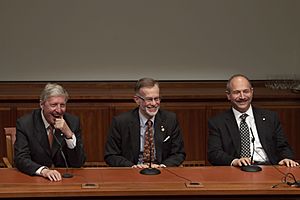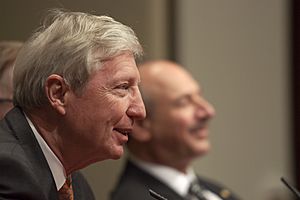Jules A. Hoffmann facts for kids
Quick facts for kids
Jules A. Hoffmann
|
|
|---|---|

Hoffmann in 2011
|
|
| Born | 2 August 1941 Echternach, German-occupied Luxembourg
|
| Nationality | French |
| Alma mater | University of Strasbourg |
| Awards | Balzan Prize (2007) Keio Medical Science Prize (2010) Nobel Prize in Physiology or Medicine (2011) Gairdner Foundation International Award (2011) |
| Scientific career | |
| Fields | Biology |
| Institutions | CNRS, University of Strasbourg, Trinity College Dublin |
| Doctoral advisor | Pierre Joly |
Jules Alphonse Nicolas Hoffmann is a French biologist born on August 2, 1941. Growing up in Luxembourg, he became very interested in insects, thanks to his father. This led him to study biology, often using insects to understand how living things work.
He works at the University of Strasbourg in France. He is also a research director at the National Center of Scientific Research (CNRS). In 2011, Hoffmann and Bruce Beutler shared half of the Nobel Prize in Physiology or Medicine. They won for their amazing discoveries about how our bodies' first line of defense, called "innate immunity," works.
Hoffmann and Bruno Lemaitre found out what the Toll gene does in fruit flies. This gene helps flies fight off infections. Later, similar genes, called Toll-like receptors, were found in mammals (like humans). These receptors help our bodies spot harmful things like bacteria and fungi. They then start an immune response to fight them off.
Becoming a Scientist
Jules Hoffmann went to school in Luxembourg before moving to France. He studied biology and chemistry at the University of Strasbourg. In 1969, he earned his Ph.D. in biology from the same university. He did more research training in Germany from 1973 to 1974.
Discovering How Bodies Fight Germs
During his Ph.D. studies, Hoffmann began looking into how grasshoppers defend themselves from germs. He found that insects have strong ways to fight off infections. He confirmed that certain cells, called phagocytes, "eat" harmful bacteria. He also showed that the ability to make new blood cells was linked to how well an insect could fight off infections.
Later, Hoffmann started using flies, like the fruit fly Drosophila melanogaster, for his research. He and his team found special proteins in flies that fight off germs. These proteins are like tiny weapons against bacteria and fungi. They also discovered that the genes making these proteins were controlled by signals similar to those found in humans.
One of his most important discoveries was about the Toll gene in fruit flies. Hoffmann and his colleague Bruno Lemaitre showed in 1996 that the Toll gene was key to how flies fight off fungal infections. They found that if the Toll gene wasn't working right, the flies couldn't fight off fungi well.
This discovery was a big deal because it showed that insects have a basic immune system, much like ours. Scientists later found that similar "Toll-like receptors" exist in many animals, including humans. These receptors are like alarm bells that tell our immune system when there's an invader. They help our bodies quickly react to bacteria and fungi, which is super important for staying healthy.
Hoffmann worked as a research assistant and later a research director at the CNRS. He also led a research unit focused on insect immune responses. From 1994 to 2005, he was the director of the Institute of Molecular and Cellular Biology in Strasbourg.
He is a member of many important science groups, like the French Academy of Sciences. In 2012, he received a high honor in France, becoming a Commander of the Legion of Honour. In 2015, Hoffmann signed the Mainau Declaration 2015 on Climate Change. This declaration was signed by many Nobel Prize winners to encourage action on climate change.
Awards and Honors
- 2003 Cancer Research Institute William B. Coley Award
- 2004 Robert Koch Prize
- 2007 Balzan Prize (with Bruce A. Beutler)
- 2010 Lewis S. Rosenstiel Award
- 2010 Keio Medical Science Prize
- 2011 Gairdner Foundation International Award
- 2011 Shaw Prize
- 2011 CNRS Gold medal
- 2011 Nobel Prize in Physiology or Medicine (with Bruce Beutler and Ralph M. Steinman)
See also
 In Spanish: Jules Hoffmann para niños
In Spanish: Jules Hoffmann para niños



